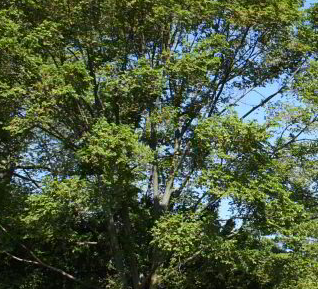The Triumph Elm, also known as Ulmus ‘Morton Glossy,’ is a tree that grows very quickly and can be utilized in a variety of settings, including as a display tree, for providing shade, or even as a street tree. It can grow to a height of 50–60 feet and a width of 35–50 feet, taking the form of an upright oval to vase. The leaves of this tree have a glossy dark green appearance in the summer, but in the fall they turn a brilliant golden color, similar to the American elms. Triumph Elm is quite adaptable and can grow in a variety of situations, including well-drained, typical, and clay soil. It is also resistant to urban environments.
The Triumph Elm is the result of a deliberate cross between the Vanguard Elm and the Accolade Elm, which Dr. George Ware of the Morton Arboretum bred. It is very resistant to diseases, including Elm yellows, Elm leaf beetle, and Dutch Elm disease. It is also resistant to Japanese beetle insects and easier to train than other elms.
Triumph Elm is worth adding to the planting list. Its beauty and endurance make it a valuable asset. It’s also a suitable alternative for the American elm, which was previously widely planted before falling victim to Dutch elm disease.
Triumph Elm Pros and Cons
The triumph tree is indigenous to Europe, Asia, and North America. Triumph trees are ideal shade trees. Apart from that, its captivating green color also enhances the beauty of the yard. One of the benefits of this Triumph Elm is its rapid growth rate, which enables it to attain nearly double the size of other trees planted in the same field in the same year. It also grows in a graceful, upright shape with strong branches, making it an eye-catching addition to any setting. The Triumph Elm, unlike other elms, is simple to train and has a more appealing young tree profile.
One of the disadvantages of this Triumph Elm is that when it grows, it might not be as appealing as other trees. The tree’s arching branches may not appeal to everyone. Additionally, despite the Triumph Elm’s resistance to many ailments and pests, some of them, including the Japanese beetle and elm leaf beetle, may still affect it.
In general, the Triumph Elm is a fantastic option for individuals who are searching for a tree that can develop quickly, is resistant to disease, has a naturally beautiful shape, and has strong branching. Unfortunately, it still has the potential to be attacked by pests and diseases, and it may not be as visually appealing as other mature trees.
Triumph Elm Growth Rate
The Triumph Elm is a fast-growing tree with a maximum height and width of 60 feet and 30 feet, respectively. It has a reputation for spreading like weeds and has a remarkable capacity to rebound from crown damage. The Triumph Elm is distinguished from other elms by its deep green, extremely glossy leaf, and robust, upright branches, which make it more appealing as a young tree. The conditions best suited for this triumph elm tree are well-draining soils and locations with enough sunlight to support its growth.
The elm requires a moderate amount of water during its first season. It is essential to increase watering frequency when the temperature outside rises. Triumph can tolerate droughts once it’s established in the yard.
Triumph Elm Problems
There are several advantages to the triumph elm tree, but there are also disadvantages that must be considered. All elm trees, especially triumph elm trees, suffer from discoloration, spotting, and defoliation. Various diseases are thought to be caused by fungi. However, bacteria are also linked to disease.
A bacterial disease differs from a fungal disease in a few ways. In bacterial situations, water flow becomes problematic as the veins of the leaves become clogged.



